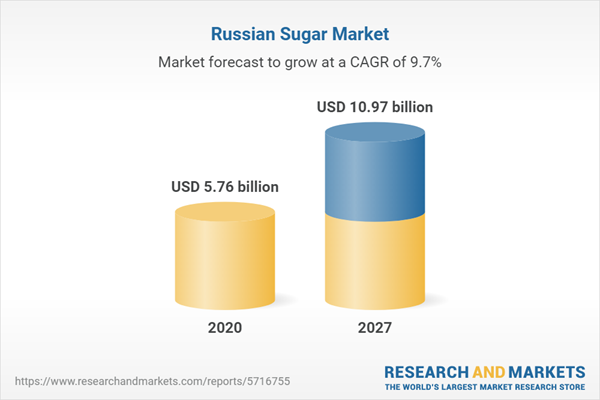The Russia sugar market is anticipated to expand at a CAGR of 9.66% over the course of the forecast period, from US$5.756 billion in 2020 to a total market value of US$10.974 billion by 2027.
The term sugar refers to a class of soluble carbohydrates that are used as a sweetener in food and have a sweet flavour. Sugar can be changed into a variety of forms after being taken from the sugar beet or sugar cane plant. Sugar can be used in the food industry in a variety of major ways in addition to giving food a sweet flavor. It prevents bacterial development and protects food. The younger population's transition to low-calorie sugar or artificial sweeteners, however, would limit the region's market.Consumption in the food industry to boost the sugar market in Russia
Consumers are requesting more sugar, which is anticipated to aid in the country's market expansion. This is a result of an increase in the consumption of added sugar-containing foods and beverages. The widespread consumption of sweet meals and desserts also contributes to the increasing demand for sugar, which will boost market expansion. A few examples of goods used industrially include beverages (such as soda, juice, yoghurt, and soymilk), ice cream, canned fruit, candies, bakeries, brewing, and medicines. Another factor that may help the market's growth is the main players' increased investment in product innovation and new product launches.Key Developments:
- July 2022: The Zemetchinsky Sugar Plant in Penza Region of Russia which is owned by the Russian Prodimex Group has opened a new line for 1 and 5 kg packages of Sugar. The daily packing capacity for 1 kg is 200 tons, while that for 5 kg is approximately 50 tons. The company will produce 85,000 tons of sugar in retail packaging per year. The packaging line's commissioning seeks to increase sugar supply to retail chains and supply the Volga Federal District and Penza Region with socially relevant products in tiny packs that are practical for customers. 240 million rubles were invested in the project. White sugar from the TS2 and Extra categories will be packaged at the new workshop. The introduction of packaging capabilities will greatly boost the volumes of packaged sugar for retail chains, stores, and end users.
- December 2021: The Federal Customs Service of Russia reports that in 2021, Russia imported sugar candy worth $209 million. While imports climbed by $ 43 million from $174 million in 2020, sales of sugar and sugar-based confections increased by 24% in Russia in 2021 compared to 2020. Additionally, Russia's exports in 2021 totaled $ 209 million. Compared to the cumulative exports of sugar confectionery in 2020, which totaled $178 million, exports of sugar confectionery increased by $30 million.
Product Offerings:
- Icing Sugar: The process of making Südzucker Icing Sugar involves crushing beet sugar into a fine, refined powder. The reduced likelihood of lumps in the final product is a result of the unique conditioning procedure. Among the general advantages of icing sugar are Quick dissolves, may speed up mixing, is very white, and is free-flowing with small, regular particle size, All Icing Sugars are non-GMO and halal- and kosher-certified. Icing sugar is frequently utilized in bread goods (for example, as a coating), sugar confectionery applications, coatings for the sweets sector, and as excipients in pharmaceutical applications.
- Südzucker Pearl Sugar: The distinctive component of the renowned Belgian Liege Waffle is Südzucker Pearl Sugar, often known as nib sugar or hail sugar. Waffles, sugar bread, brioches, French chouquettes, and Pulla buns are among the baked foods that contain pearl sugar as a decorative ingredient, crunchy texturizer, and sweet bite of deliciousness. Pearl Sugar is used as the centre filling for colorful sweets embellishment in sugar confectionery. It works well for ice cream as well, when brésilienne can be made from tiny sugar pearls coated in syrup. The finest sugar is used to create Südzucker Pearl Sugar, which has a lovely bright white color and a delightfully crunchy texture.
Market Segmentation:
By Form
- Sugar Cubes
- Granulated Sugar
- Powdered Sugar
- Sugar Syrup
By Source
- Cane Sugar
- Beet Sugar
By Use
- Food and Beverage
- Pharmaceuticals
By Distribution Channel
- Online
- Offline
Table of Contents
INTRODUCTION1.1. Market Overview
1.2. COVID-19 Scenario
1.3. Market Definition
1.4. Market Segmentation
RESEARCH METHODOLOGY
2.1. Research Data
2.2. Assumptions
EXECUTIVE SUMMARY
3.1. Research Highlights
MARKET DYNAMICS
4.1. Market Drivers
4.2. Market Restraints
4.3. Porter’s Five Forces Analysis
4.3.1. Bargaining Power of Suppliers
4.3.2. Bargaining Power of Buyers
4.3.3. Threat of New Entrants
4.3.4. Threat of Substitutes
4.3.5. Competitive Rivalry in the Industry
4.4. Industry Value Chain Analysis
RUSSIA SUGAR MARKET ANALYSIS, BY FORM
5.1. Introduction
5.2. Sugar Cubes
5.3. Granulated Sugar
5.4. Powdered Sugar
5.5. Sugar Syrup
RUSSIA SUGAR MARKET ANALYSIS, BY SOURCE
6.1. Introduction
6.2. Cane Sugar
6.3. Beet Sugar
RUSSIA SUGAR MARKET ANALYSIS, BY USE
7.1. Introduction
7.2. Food and Beverages
7.3. Pharmaceuticals
RUSSIA SUGAR MARKET ANALYSIS, BY DISTRIBUTION CHANNEL
8.1. Introduction
8.2. Online
8.3. Offline
COMPETITIVE INTELLIGENCE
9.1. Major Players and Strategy Analysis
9.2. Emerging Players and Market Lucrativeness
9.3. Mergers, Acquisitions, Agreements, and Collaborations
9.4. Vendor Competitiveness Matrix
COMPANY PROFILES
10.1. SÜDZUCKER AG
10.2. WILMAR INTERNATIONAL LTD
10.3. RUSAGRO
*List is not exhaustive
Companies Mentioned
- Südzucker AG
- Wilmar International Ltd
- Rusagro
Methodology

LOADING...
Table Information
| Report Attribute | Details |
|---|---|
| No. of Pages | 70 |
| Published | January 2023 |
| Forecast Period | 2020 - 2027 |
| Estimated Market Value ( USD | $ 5.76 billion |
| Forecasted Market Value ( USD | $ 10.97 billion |
| Compound Annual Growth Rate | 9.6% |
| Regions Covered | Russia |
| No. of Companies Mentioned | 3 |









